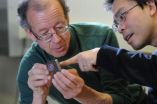How did early primordial cells evolve?
2013-02-28
(Press-News.org) VIDEO:
L-form bacteria undergoes cell division. The time scale is in minutes.
Click here for more information.
Four billion years ago, soon after the planet cooled enough for life to begin, primordial cells may have replicated and divided without protein machinery or cell walls, relying instead on just a flimsy lipid membrane. New research on bacteria examines exactly how these primitive cells could have evolved without such crucial structures. While the vast majority of bacteria have cell walls, many bacteria can switch to a wall-free existence called the L-form state, which could mirror the structure of primordial cells. A study published by Cell Press February 28th in the journal Cell reveals how bacteria in this L-form state divide and proliferate, shedding light on how the earliest forms of cellular life may have replicated.
"The main surprise for me was how simple the mechanism was. It doesn't require any sophisticated protein-based machinery," says senior study author Jeff Errington of Newcastle University. "This makes it plausible as an explanation for how very primitive cells could have proliferated in the very early days of evolution."
The cell wall is a layered structure surrounding cells that protects them and maintains their shape. It is present in all known major bacterial lineages, and it was also probably present in the last common ancestor of bacteria. This structure is so important that it is targeted by antibiotics, and many bacteria responsible for infectious diseases can switch to the L-form state to resist antibiotics.
Perhaps the most striking change associated with the L-form state is the way that the bacteria replicate. Instead of relying on precise, complicated cell division machinery, L-form bacteria become irregularly shaped and form cell surface bulges that pinch off to become daughter cells. Although genetic mutations associated with the L-form state have been identified, little is known about the molecular mechanisms underlying L-form replication.
Addressing this question in the new study, Errington and his team identified two genetic changes required for L-form growth in bacteria. One of these mutations was necessary for the increased production of fatty acids in the cell membrane, which would be expected to increase the cell's surface area relative to its volume. Indeed, the researchers found that by artificially increasing cell surface area, they could induce L-form-like shape changes and cell division. The findings suggest that a simple biophysical change—an imbalance between surface area and volume—underlies L-form cell division.
"Our study paves the way for understanding how L-form bacteria cause disease and resist antibiotics," Errington says. "It also offers a model system for future experiments aimed at exploring the possible replication mechanisms of primitive cells that could have existed before the explosion of bacterial life on the planet nearly four billion years ago."
###
Cell, Mercier et al.: "Excess membrane synthesis drives a primitive mode of cell proliferation."
END
ELSE PRESS RELEASES FROM THIS DATE:
2013-02-28
WEST CHESTER, Pa., February 28, 2013 – Animas Corporation announced today positive results from the second phase of human clinical trials of a first-generation, closed-loop insulin delivery system in development, designed to predict a rise or fall in blood glucose and correspondingly increase, decrease, suspend and resume insulin delivery. The data were presented at the Advanced Technologies & Treatments for Diabetes (ATTD) Conference in Paris, France.
The feasibility study of the predictive Hypoglycemia-Hyperglycemia Minimizer (HHM) System* in development was conducted ...
2013-02-28
An international team led by Sascha Quanz (ETH Zurich, Switzerland) has studied the disc of gas and dust that surrounds the young star HD 100546, a relatively nearby neighbour located 335 light-years from Earth. They were surprised to find what seems to be a planet in the process of being formed, still embedded in the disc of material around the young star. The candidate planet would be a gas giant similar to Jupiter.
"So far, planet formation has mostly been a topic tackled by computer simulations," says Sascha Quanz. "If our discovery is indeed a forming planet, then ...
2013-02-28
Philadelphia, Pa. (February 28, 2013) – Performed an average of a decade after initial facelift surgery, a "secondary" facelift can achieve similarly lasting results with a low complication rate, according to a paper in the March issue of Plastic and Reconstructive Surgery®, the official medical journal of the American Society of Plastic Surgeons (ASPS).
Dr. Rod J. Rohrich and colleagues of University of Southwestern Medical Center, Dallas, report their 20-year experience with secondary facelift surgery, or "rhytidectomy." The researchers conclude that, with attention ...
2013-02-28
Philadelphia, Pa. (February 28, 2013) –For women undergoing breast reconstruction using implants, most patient-reported outcomes are similar with two different shapes of silicone gel-filled implants, reports a study in the March issue of Plastic and Reconstructive Surgery®, the official medical journal of the American Society of Plastic Surgeons (ASPS).
Assessment of key areas of quality of life after breast reconstruction shows few significant differences with conventional round implants versus newer "shaped" implants, according to the new research, led by Dr. Sheina ...
2013-02-28
Bethesda, MD—Women who are pregnant or using synthetic progesterone birth control injections have a conspicuous vulnerability to certain infections including malaria, Listeria, HIV, and herpes simplex virus. A new research report appearing in the March 2013 issue of the Journal of Leukocyte Biology offers strong evidence for a possible explanation: the progesterone receptor, a pregnancy hormone sensor, targets a part of the immune system responsible for protection against these and other invaders. In addition to helping explain why some women are more vulnerable to certain ...
2013-02-28
PROVIDENCE, R.I. [Brown University] — A team of neuroengineers based at Brown University has developed a fully implantable and rechargeable wireless brain sensor capable of relaying real-time broadband signals from up to 100 neurons in freely moving subjects. Several copies of the novel low-power device, described in the Journal of Neural Engineering, have been performing well in animal models for more than year, a first in the brain-computer interface field. Brain-computer interfaces coud help people with severe paralysis control devces with their thoughts.
Arto Nurmikko, ...
2013-02-28
DURHAM, N.C. -- Researchers have electronically linked the brains of pairs of rats for the first time, enabling them to communicate directly to solve simple behavioral puzzles. A further test of this work successfully linked the brains of two animals thousands of miles apart—one in Durham, N.C., and one in Natal, Brazil.
The results of these projects suggest the future potential for linking multiple brains to form what the research team is calling an "organic computer," which could allow sharing of motor and sensory information among groups of animals. The study was published ...
2013-02-28
Canola, cottonseed, and sunflower products can replace soybean meal in diets fed to pigs, but they contain less protein and energy. To determine if it makes economic sense to use them, producers need to know the concentrations and digestibility of the nutrients they contain. To help them make the decision, University of Illinois researchers examined amino acid digestibility for these products.
"Soybean is by far the biggest oilseed crop in the world," said Hans Stein, professor of animal sciences. "But canola, cottonseed, and sunflowers are grown in areas where soybeans ...
2013-02-28
Bethesda, MD—Earth Day may be more than a month away, but another, more personal, ecosystem has been shown to also be worth protecting—within our bodies are communities of microbes that affect the behavior of human cells hosting them. These communities, called the "microbiome," are so crucial to our health that some consider it to be a complex "second genome." Understanding the interaction of these microbes among one another and their human hosts has the potential to yield insights into numerous diseases and complex human disorders from obesity to susceptibility to infection. ...
2013-02-28
A European study published in the 'Cancer Epidemiology, Biomarkers & Prevention' journal has analysed the association between physical activities and in situ or non-invasive breast cancer, or, in other words, cancer that has not yet invaded cells within or outside of the breast.
Headed by researchers from ten European countries including Spain, the work carried out under the framework of the European Prospective Investigation into Cancer and Nutrition (EPIC) concludes that physical activity has no relation with the risk of developing this type of non-invasive cancer. ...
LAST 30 PRESS RELEASES:
[Press-News.org] How did early primordial cells evolve?



